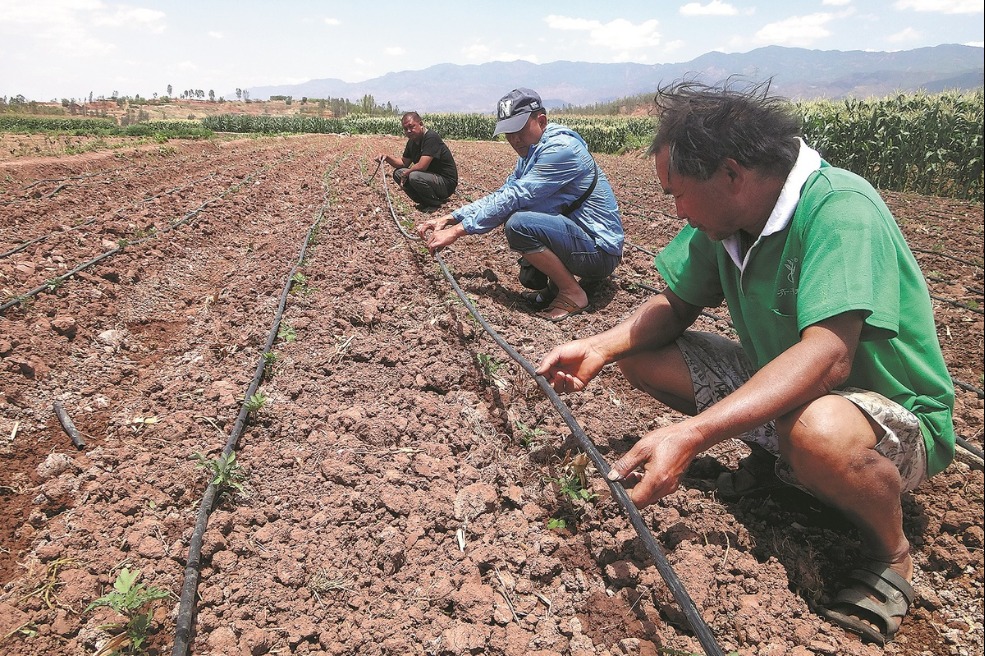'Moon bricks' to be sent to space station
Use of simulated soil could aid future plans to set up lunar research outposts

Chinese scientists have made some bricks using simulated lunar soil and plan to send them to the nation's Tiangong space station for experiments, according to China Central Television.
The State broadcaster quoted Professor Zhou Cheng from Huazhong University of Science and Technology, where the bricks were made, as saying on Saturday that the interlocking blocks were made inside a vacuum hot-pressing furnace that heated the materials, which simulated the composition of real lunar soil, up to about 1,000 C to be sintered.
Each brick is more than three times stronger than a standard red brick or concrete brick, which means each square centimeter is able to support more than 1 metric ton of weight, he said.
The composition of lunar soil varies in different locations on the moon, Zhou said, noting that there is one composition of the brick that simulates the soil at the landing site of China's Chang'e 5 probe, which is mainly basalt. Some other compositions simulate the soil found at other locations, which is mainly anorthosite.
According to the professor, the bricks must be capable of enduring the harsh environment on the lunar surface, including extreme temperature changes, cosmic radiation and impacts from micrometeorites.
The temperature on the moon can exceed 180 C during the day and drop to as low as-190 C at night, so the bricks must have strong thermal insulation properties.
The absence of an atmosphere on the moon also means the bricks will be exposed to strong cosmic radiation and strikes from micro-meteorites, as well as high-frequency lunar quakes, according to Zhou, who is a leading member of the National Center of Technology Innovation for Digital Construction of the university in Wuhan, Hubei province.
Therefore, he said, researchers plan to place samples of the bricks outside the Tiangong space station to undergo exposure experiments, which will range from one to three years. The samples will be transported by the Tianzhou 8 cargo spaceship, which is scheduled to set out in the coming weeks from the Wenchang Space Launch Center in Hainan province. After the experiments, the samples will be sent back to Earth for researchers to examine, the professor noted.
Pang Zhihao, an expert on space exploration technology who worked at the China Academy of Space Technology for decades, explained that China has announced its goal of building an international research outpost on the moon in the near future, and that means Chinese scientists and engineers need to figure out how to construct infrastructure on the silver sphere without materials from Earth.
Launching materials to the moon is tremendously expensive and sophisticated, so using lunar resources while on the moon could greatly reduce costs and make further lunar exploration more probable, he said, adding that this is known as in situ resource utilization.
"Many researchers have suggested that lunar materials can be turned by 3D printers into construction materials or solar panels used to build roads, structures and power stations," he said.
"If that comes true, humans will be able to set up bases that can support longtime robotic operations and short-duration human stays. The in situ resource utilization on the moon will also allow for demonstrations of manned expeditions to other planets such as Mars."
China opened its lunar exploration program in 2004 and has launched six robotic probes since 2007. The most recent mission, the Chang'e 6, landed on the moon's far side in June and soon returned nearly 2 kilograms of lunar rocks and soil back to Earth, marking a historic feat in lunar exploration.
zhaolei@chinadaily.com.cn





































